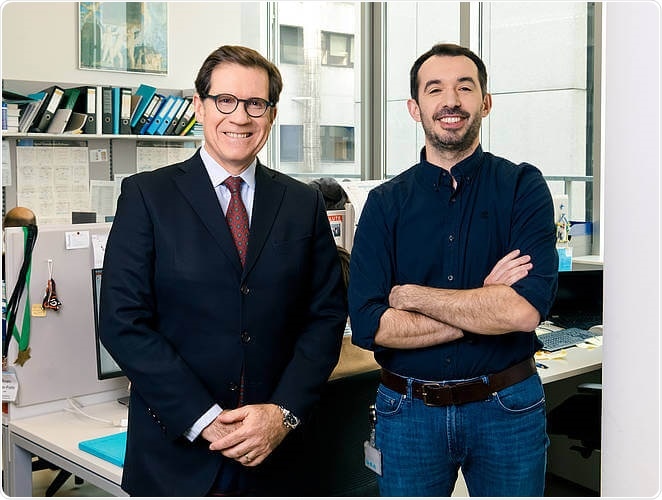At the CeMM Research Center for Molecular Medicine of the Austrian Academy of Sciences, scientists have investigated how solute carriers (SLCs)—a large class of membrane transport proteins—affect the activity and potency of cytotoxic drugs, for example, those used to treat leukemia and other cancers.

Last author Giulio Superti-Furga and first author Enrico Girardi. Image Credit: © Klaus Pichler / CeMM.
The study was reported recently in the Nature Chemical Biology journal and reveals that most of the drugs analyzed rely on the function of at least one SLC. In certain cases, the drug requires the transporter to penetrate the cell, and in others, it provides small molecules (metabolites) that are vital for the drug’s activity or the response of the cell to the molecule.
The study outcomes highlight the biological roles of transporters, paving a way to develop next-generation precision therapies.
SLCs constitute the largest class of transmembrane transporters in the human genome, including more than 400 members falling into 65 families. They play a crucial role in determining the cellular metabolism and regulate important physiological functions, such as ion transport, nutrient uptake, and waste removal.
SLCs play a vital role in maintaining the internal state of the human body (called homeostasis) stable. However, the occurrence of genetic variation (polymorphisms) in SLCs is related to various diseases such as diabetes or gout, while gene mutations are the cause of hundreds of disorders, including several metabolic deficiencies and orphan diseases.
It has been demonstrated that SLCs serve as drug targets and constitute paths for the absorption of drugs into particular organs. Although several decades of studies have been performed, systematic surveys of transporter-drug relationships in human cells are yet to be performed.
Finding out how a specific drug enters human cells and how cell’s metabolism reacts to them is crucial for achieving better insights into the adverse effects and limitations of existing drugs and thereby formulating more effective drug therapies for the future.
Following on from an earlier study that helped discover how a single SLC—SLC35F2—is essential in the uptake of YM-155—a cytotoxic compound—Giulio Superti-Furga and team at CeMM conducted a systematic investigation on how the solute carriers determine the activity of a large and diverse set of cytotoxic compounds. The aim was to survey “how” and “how often” SLC transporters lose or influence the activity of a specific drug.
In the study, the researchers at CeMM created a CRISPR/Cas9-focused library particularly targeting 394 SLCs and applied this to determine the SLCs that affected the activity of a panel of 60 chemically diverse cytotoxic compounds, of which most of them were clinically approved.
It was determined that nearly 80% of the screened drug set exhibits a dependency with at least one solute carrier. For further validation of the results, the scientists individually verified a subset of SLC-drug interactions and used transcriptomics approaches and uptake assays to study how some of the SLCs influenced the drug uptake and activity.
The use of a custom-made, SLC-focused library was instrumental in allowing us to screen a large number of compounds, revealing hundreds of SLC-drug associations and providing many novel insights into SLC biology and drug mechanisms.”
Enrico Girardi, Study First Author and Senior Postdoctoral Fellow, CeMM Research Center for Molecular Medicine of the Austrian Academy of Sciences
The current study is the outcome of a cross-disciplinary collaboration with scientists from the University of Vienna, Pharmacoinformatics Research Group of Gerhard Ecker, and the group of Stefan Kubicek at CeMM.
The study not just offers a strong validated argument to show the necessity of SLCs in cellular uptake and drug activity, but also an experimentally validated set of SLC-drug correlations for various clinically applicable compounds.
The proof offered by the researchers at CeMM paves the way for further analyses of the genetic determinants of drug activity, specifically uptake in human cells.
This study raises strong doubts that the generally accepted idea that most drugs can enter cells by simply diffusing through its membrane is correct and highlights the increasingly appreciated need to systematically studying the biological roles of solute carriers.”
Giulio Superti Furga, Study Last Author and Scientific Director, CeMM Research Center for Molecular Medicine of the Austrian Academy of Sciences
A better understanding of how the transporters influence the uptake and activity of drugs in tissues and tumors would enable researchers to predict and counteract resistance mechanisms to develop precision therapies that are highly effective.
Moreover, insights into the link between the expression of SLCs, cellular/organismal metabolism, and nutrition could pave the way for innovative therapeutic avenues in the years to come.
Source:
Journal reference:
Girardi, E., et al. (2020), A widespread role for SLC transmembrane transporters in resistance to cytotoxic drugs. Nature Chemical Biology. dx.doi.org/10.1038/s41589-020-0483-3.